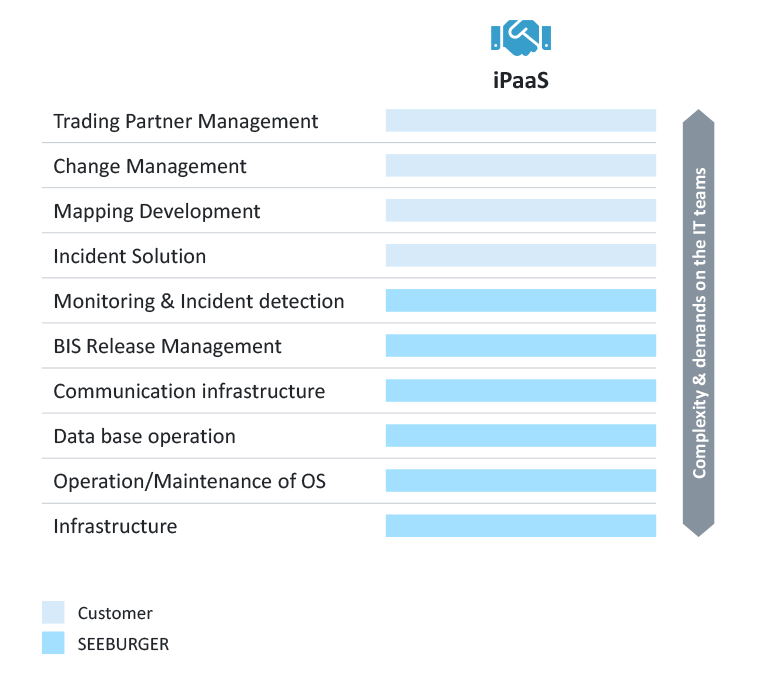What to Consider Before Moving Operations Into the Cloud: The Perfect Cloud Service Contract

Businesses and their products and services are constantly evolving. More than ever, this is being driven by the digitalization of their processes. The complexity of the technological and organisational design of these business processes, paired with the need for scalability and agility, have significantly increased the demand for cloud service contracts. However, unlike running cloud applications, moving operations to the cloud is no small undertaking. You will need to consider several aspects before signing a cloud service contract. This article highlights the most important steps on your journey into the cloud.
First of all – congratulations! If you are already assessing your requirements for a cloud service contract, you have taken the right steps in preparing your business for the future. Your company will be able to benefit from the highest security measures, high operational reliability, unlimited scalability and low risk with maximum availability.
Good preparation is key to a perfect cloud service contract
To begin with, let us focus on the example of migrating your EDI business into a cloud environment. This has been the most common use case for years. Before signing a cloud contract, remember that moving your EDI business to the cloud means entering a joint partnership with a cloud service provider for a minimum of 36 months. It is therefore very important to assess and choose your provider carefully before entering a long-term business partnership.
Before you choose an integration partner, you will need to know your needs and requirements concerning data security as well as how many employees you can afford to have in your EDI team. Both will have an influence on the most appropriate operating model for your organisation. The cloud operating model can vary from an on-premises system in a private cloud to a highly available full managed service or iPaaS (Integration Platform as a Service). Aspects you will need to consider include where the data centre is located (e.g. USA, Germany or China) and whether certain services, such as mapping development or onboarding partners, are kept in house or managed on your behalf.
What to expect when setting up a cloud service contract
Are you clear on what services are to be operated in the cloud? What service level will you need for your organization? What would be the best cloud architecture for your business size and message volume? Would a shared, private or public cloud be most suitable? Another important aspect to consider is your company’s archiving and/or disaster recovery needs. These should be in line with the rules and guidelines in your organization, as well as the national regulations of the countries in which you are active.
The key to smooth migration is preparation. Do not skimp on this groundwork. Instead it’s worth setting up a project team to analyse and define the processes to be migrated. In concrete terms, this means gathering all the relevant information on your trading partners. How many partners are there? How do you connect with them? What message types do they use? How are these encrypted? How will you onboard them to the new system? Don’t forget to look at the data itself. How much is there? How is it structured?
Think of tomorrow today – the importance of scalability and agility in a cloud service
The work doesn’t stop once you’ve successfully migrated everything to the cloud. You also need to plan for after the go live and ramp up phases, when everything is running smoothly. You will need to name at least one person responsible for liaising with the cloud service provider on an ongoing basis and for managing any change requests coming from your employees.
Technological advances are happening so fast that your company’s needs are likely to change quicker than you expect. To this end, your company will need a clear technical strategy which aligns with your company’s overall goals, with someone to take responsibility for this. With this in mind, there are several questions you need to put to your service provider. Is your cloud provider willing and able to let you scale up as necessary? How will they deal with new and emerging integration patterns and technologies? Do they use point to point mappings, or do they convert into a canonical format or even offer pre-built connectors?
A current trend in business integration is using APIs to integrate digital services. If you are looking for an API-ready cloud contract, an iPaaS would best fit your needs. It enables your IT teams to implement real-time data processing between any of your business partners’ technologies, including IIoT or industry 4.0. This means maximum agility and efficiency for you.
How to secure a successful partnership with your cloud service provider
An iPaaS is a more flexible cloud option, which puts you firmly in the driving seat. As you can imagine, this involves a little more effort for your organisation. Be clear about where your responsibilities end and your service provider’s start. You will also need to appoint a dedicated team in advance so that you have named individuals for the elements you keep in-house. There are various organizational tools which will help you to set out and allocate responsibilities so that everyone knows what they need to do and who they need to liase with before going live.
The sample matrix below makes it clear what needs doing and by whom. This in an integral step towards creating a successful partnership.

How is the monthly rate for your cloud services calculated?
Essentially, all the aspects detailed above will have an influence on how much you will pay monthly for your cloud services. A significant advantage for you is that instead of investing a large lump sum to be depreciated over a certain period of time, you will be paying the same, manageable sum every month. This not only makes budgeting easier, it also frees up cash to be spent elsewhere in your organisation.
Have you thought of everything? A sample checklist for successful cloud service migration
- find a reliable partner for a long-term business relationship (contract length ≥ 36 months)
- define your data security needs
- location of data centre
- public, private or shared cloud
- define target size of your own integration team when choosing the operating model
- hosting
- iPaaS
- full managed service
- define service level
- basic
- advanced
- premium (24/7)
- establish rules & guidelines for your organization
- archiving yes/no
- disaster recovery – basic, advanced or premium?
- set up a dedicated project team for initial groundwork
- establish how much data is transmitted on a monthly basis
- define who is responsible for onboarding trading partners
- define how to deal with change requests and ongoing development
- agree on roles & responsibilities
How can SEEBURGER support you?
SEEBURGER Cloud Services make integration and the electronic exchange of data with business partners easy, transparent and secure. The SEEBURGER Business Integration Suite is a single, all-in-one solution, with modular services which can be combined to meet your specific needs at any given time. There are many ways to deploy the SEEBURGER Business Integration Suite in a cloud, whether on-premises in a private cloud, in a public cloud, as an iPaaS, or as a full service integration platform in the SEEBURGER cloud. Contact us today to find the best solution for your needs!
Thank you for your message
We appreciate your interest in SEEBURGER
Get in contact with us:
Please enter details about your project in the message section so we can direct your inquiry to the right consultant.
Written by: Manuel Veith
Manuel Veith is a Presales Engineer for cloud and managed services at SEEBURGER. Manuel worked in the automotive industry from 2001 to 2021 where he spent the last ten years involved in subscription & pay per use business models. He recently joined SEEBURGER to combine his information systems degree with his professional experience in sales.





